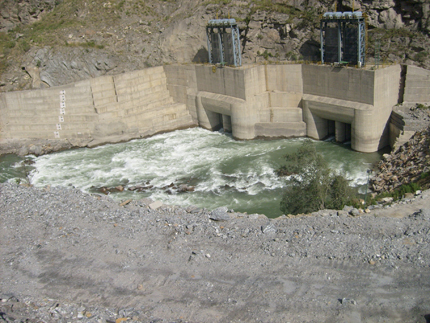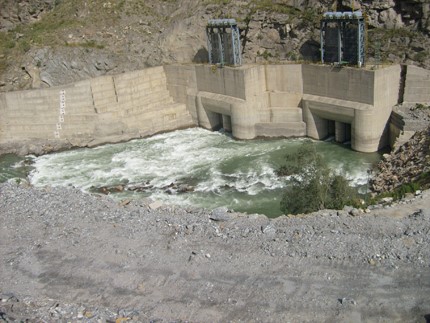A report commissioned by India’s Central Water Commission has recommended scrapping 15 of the 44 large hydroelectric projects planned on the Brahmaputra and its tributaries in Arunachal Pradesh

The Indian government has sanctioned hydroelectric and thermal power projects with a total capacity of around 50,000 megawatts (MW) in the recent past, finance minister Palaniappan Chidambaram claimed in parliament this week while presenting the country’s interim budget in this election year.
He did not take into account a recent report done under the aegis of a government body, the Central Water Commission. The report has recommended scrapping 15 of the 44 hydroelectric projects planned on the Siang river and its tributaries in Arunachal Pradesh in the north-east of India. Siang is the local name of the Brahmaputra, a 2,900-kilometre long transboundary river that flows through China, India and Bangladesh and drains much of the eastern Himalayas. In all, the 44 projects are meant to generate 18,293 MW, nearly 36% of the figure quoted by the finance minister for the entire country.
Many residents of Arunachal Pradesh and on the banks of the river in the Assam valley downstream have been opposing the projects, and so have environmentalists. Independent experts have called for a redesign of another dam downstream in the basin. In a recently published book, Brahmaputra: Towards Unity, academics, researchers and NGOs from Bangladesh, China and India have called for joint sustainable development of the entire basin instead of the piecemeal projects being planned and carried out by the governments of China and India.
Now for the first time, these points of view have been supported by a report commissioned by a government organisation under the union Ministry of Water Resources.
The report has also suggested stricter regulations for all hydroelectric projects that are planned in Arunachal Pradesh. The matter will now be considered by the Ministry of Environment and Forests, which has been on a recent project clearance spree under its new minister Veerappa Moily.
Still, the report will provide fresh ammunition to local protesters and environmentalists, who are planning to go to court if the environment ministry ignores the findings. The report says all the 44 projects will adversely affect the ecology of the river and the entire region, including the entire downstream stretch in Assam. The projects will hit a stretch of over 500 km along the river, especially since 353 kilometres will be turned into reservoirs and the river will be made to travel through tunnels for 160.8 kilometres more.
Over 18,000 hectares of forests will be destroyed or damaged, says the report, which will be discussed by the forest advisory committee of the environment ministry at its next meeting. That meeting had originally been called to assess one of the 44 projects, a 700 MW project called Tato II. The ministry has said this will be the first project in the river basin to come up for clearance, though it had assessed the 1,000 MW Siyom (or Middle Siang) project ten years ago.
The committee is also scheduled to review the Lower Yamne Stage I and II projects, with a total planned generation capacity of 184 MW. The Yamne is a tributary of the Siang. The report points out that this sub-basin has the highest biodiversity value in the overall Siang basin.
Looking at the projects together, the report says, “Siang Lower HEP (2,700 MW), Siang Upper Stage II (3,750 MW) and Siang Upper Stage I (6,000 MW) are planned to cover almost the entire length of the Siang in India. 208.5 kilometres of the river will be converted into one continuous reservoir as all three projects are planned back-to-back without any free flowing intermediate river stretch.”
In recent years, proponents of large hydroelectricity projects have pointed out that many of these are ‘run of the river’ projects, which do not have reservoirs. That is the point on which they have defended these projects. But what this does not mention is that run of the river projects also have dams, and for large projects these dams are just as large as in reservoir projects. Instead of holding the water back in reservoirs, these dams channel the water through tunnels blasted into the river bank mountainsides. These tunnels carry the water with a very slight slope, sometimes for as long as nine kilometresm, before the water falls vertically, turning the hydroelectricity turbines before flowing back to the river bed.
Another run of the river project under construction: The 1,200 MW Punatsangchhu I project in BhutanAt the beginning of the tunnels, the water is first stored in tanks so that the silt being carried by the river settles down. Since the Himalayas are the youngest mountains on earth, they are constantly crumbling faster than other mountains, and all its rivers carry heavy silt loads. This silt would damage the turbine blades unless removed from the water. However, this is the same silt that rejuvenates the soil downstream. Following protests from agricultural scientists, most run of the river projects now have tunnels at the bottom of the settlement tanks so that the silt can flow down to the river bed. But it falls into a dry river bed just behind the dam wall, and there is no mechanism to take it down for kilometres to the point where the water is flowing again. Farmers downstream in the Brahmaputra – especially in Dhemaji and Dibrugarh districts of Assam but also as far as Sirajganj in Bangladesh – have complained that recent floods left behind a load of sand rather than fertile silt when the waters receded.
The problem would have been solved, at least partially, if the dams did not channel the entire river into the tunnels. That is one of the most controversial topics at the policy level in India now, with environmentalists insisting that least 50% of the river must be allowed to run free, while hydroelectricity engineers their projects will be unviable unless they channel at least 90% of the water. During the construction period – which can go on for up to 12 years – the entire river is blocked and channelled anyway, since the engineers say they need a dry river bed to build the tunnels. None of the river species can move upstream or downstream.
The problem is compounded by these run of the river projects coming in a stream, with the next dam sometimes appearing within a kilometre or two of where the water has been released by the previous project.
The report says, “It is strongly recommended that after dropping these projects, these river reaches should be kept free. These projects should not be re-allotted by altering their features, locations and names. Also on other free stretches/tributaries, no further hydropower projects should be planned/allotted in the entire Siang basin even if they are small (less than 25 MW) and do not fall within the purview of the EIA (environmental impact assessment) notification.” The small projects have been planned to have a total capacity of 473.5 MW.
The reference to re-allotment stems from previous attempts by hydropower proponents to change some features, location or just the name of a project when it has been rejected, and then submit their application all over again.

